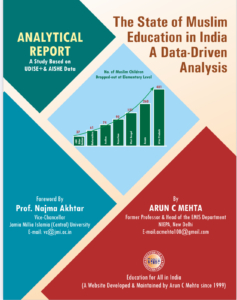Early Childhood Education in NEP 2020
Data Gaps in UDISE+ and the Role of Anganwadi Centers
Introduction
India’s National Education Policy (NEP) 2020 marks a pivotal reform in the education sector, integrating Early Childhood Care and Education (ECCE) into the foundational stage (ages 3-8) of its 5+3+3+4 structure. Recognizing that over 85% of a child’s brain development occurs before age six, NEP 2020 emphasizes play-based, multilingual learning to foster cognitive, physical, and socio-emotional growth. By extending the Right to Education Act to ages 3-18, the policy aims for universal ECCE access to bridge socio-economic disparities. However, challenges in data collection through the Unified District Information System for Education Plus (UDISE+) and the historical placement of Anganwadi and Balwadi centers under the Ministry of Women and Child Development (MWCD) create significant gaps. This article explores these issues, incorporating recent MWCD guidelines, historical context, and insights from platforms like Education for All in India, advocating for integrated systems to realize NEP’s vision.
Historical Perspective: The Origins of Anganwadi and Balwadi Centers under the Ministry of Women and Child Development
The evolution of ECCE in India is tied to the Integrated Child Development Services (ICDS) scheme, launched on October 2, 1975, under MWCD. Designed to address malnutrition, high infant mortality, and gender inequalities, ICDS delivers a holistic package of services: supplementary nutrition, immunization, health check-ups, non-formal preschool education, and maternal health support. Anganwadi centers, meaning “courtyard shelters,” serve children aged 0-6, pregnant women, and lactating mothers in rural and urban slum areas. Balwadis, often community-run, focus on play-based learning for underprivileged children. Unlike school-based pre-primaries under the Ministry of Education (MoE), ICDS centers fall under MWCD due to their integration of health, nutrition, and women’s empowerment, reflecting a welfare-oriented approach rooted in the 1974 National Policy for Children.
This separation was strategic, addressing intergenerational poverty through converged health and education interventions. By the 1980s, ICDS scaled to millions, but uneven implementation persisted. Today, over 1.3 million Anganwadis serve approximately 70 million beneficiaries, yet their exclusion from MoE’s UDISE+ system complicates NEP 2020’s goal of unified ECCE. For readers of Education for All in India, understanding this historical divide is key to addressing systemic challenges in Indian education.
Review of Literature
Literature on NEP 2020 underscores its potential to reduce learning gaps through ECCE, with a play-based curriculum enhancing school readiness and long-term outcomes. Studies highlight implementation challenges, including inadequate teacher training and infrastructure in underserved areas. On ICDS, research praises its impact on nutrition and pre-school attendance but notes variability in educational quality due to overburdened Anganwadi workers. Critiques of UDISE+ reveal its focus on school-attached pre-primary sections excludes MWCD-run centers, skewing indicators like the Gross Enrolment Ratio (GER), estimated at 41.4% for the foundational stage in 2024-25. Analyses on Education for All in India, particularly their review of NEP’s progress, advocate for data harmonization to support evidence-based planning.
Provisions in UDISE+ and the Incompleteness of Pre-Primary Data
UDISE+, managed by the MoE, is a comprehensive database capturing school education data from pre-primary to Grade 12. Post-NEP 2020, UDISE+ was enhanced to include school-attached pre-primary sections, aligning with the foundational stage and improving metrics like pupil-teacher ratios (10:1 in 2023-24). However, Anganwadis and Balwadis, under MWCD, are excluded due to their non-school status, despite serving millions. With over 1.3 million Anganwadis, this omission underestimates ECCE participation, as UDISE+ data does not reflect their contributions. For example, while UDISE+ reports a 41% GER for the foundational stage, including Anganwadi data could show higher coverage. As detailed on Education for All in India, this gap hinders NEP’s goal of seamless ECCE integration.
New MWCD Guidelines on ECCE (2025)
On September 3, 2025, the MWCD, in collaboration with the MoE, launched guidelines to strengthen ECCE by co-locating over 2.9 lakh Anganwadi Centres with schools, aligning with NEP 2020’s 5+3+3+4 structure. Key features include:
- Co-location: Integrates Anganwadis with schools to enhance infrastructure, teacher collaboration, and community engagement for children aged 3-6.
- Operational Framework: Clarifies curriculum integration, space sharing, and roles of Anganwadi workers and school staff, with flexibility for local adaptation.
- Training Enhancement: Equips Anganwadi workers with improved training and school facilities to deliver ECCE, health, and nutrition services.
- Curriculum Alignment: Builds on the 2024 Aadharshila Curriculum, promoting competency-based, holistic learning via the Panchakosha concept.
- Strategic Goals: Supports foundational learning to improve long-term outcomes, contributing to India’s vision of a developed nation.
These guidelines foster MWCD-MoE collaboration, but data integration with UDISE+ remains a challenge, as Anganwadis are not yet included in formal school data systems.[47]
Concluding Observations
NEP 2020’s integration of ECCE into the foundational stage is a progressive step toward educational equity, but the historical placement of Anganwadis under MWCD creates data and implementation challenges. The 2025 MWCD guidelines on co-locating Anganwadis with schools mark significant progress in bridging these silos, enhancing ECCE access and quality. However, UDISE+’s exclusion of MWCD-run centers continues to skew national data, underrepresenting participation and hindering policy evaluation. A unified data platform, as advocated by Education for All in India, could capture all ECCE providers, ensuring evidence-based planning. For the platform’s readers, these insights emphasize the need for sustained efforts to harmonize systems, reduce dropout rates, and strengthen foundational skills, aligning with NEP’s vision of inclusive education.


